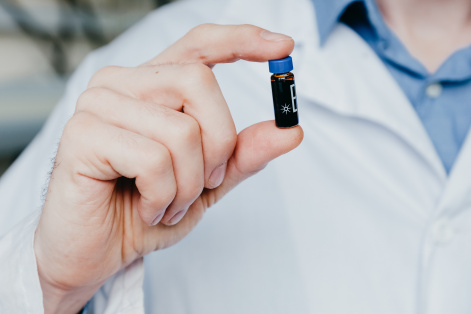Krasnoyarsk scientists have found a recipe for a solution with an unprecedented concentration of silver nanoparticles
3 December 2020 г.

Many modern technologies, for example, 3D and 2D printing, biomedicine, optoelectronics and synthesis of composite nanomaterials require a large number of nanoparticles with adjustable size and shape. However, there are not so many cost-effective and environmentally friendly methods for producing such objects.
Scientists from the Federal Research Center "Krasnoyarsk Science Center SB RAS" and M.F. Reshetnev Siberian State University of Science and Technology are the first in the world to have obtained ultra-concentrated solutions, which contain up to 1500 grams of silver nanoparticles per liter. To do this, they modified the usual method for synthesizing nanoparticles.
The most common method for producing metal nanoparticles is the “wet” chemical synthesis, where a liquid, such as water, is used as a medium. It was this method that the scientists chose decided to employ in order to create silver nanoparticles. This method allows one to easily control the size, composition and structure of nanoparticles, the reaction being also quite simple. An aqueous solution of sodium citrate is mixed with a solution of ferrous sulfate, and a solution of silver nitrate is added to the resulting mixture. As a result of the reagent interaction, a precipitate of silver nanoparticles falls to the bottom. Next, the resulting solution is centrifuged to separate the precipitate and the solvent, to be further purified from impurities. However, even these procedures make it possible to obtain a precipitate, with only a few tens grams of nanoparticles contained in a liter. Therefore, it is necessary to perform additional procedures to improve the particle concentration, and, as a consequence, to dispose of large volumes of waste solutions.
To synthesize more concentrated solutions with silver nanoparticles, Krasnoyarsk chemists modified the method. The scientists used filtration instead of centrifugation and substituted the precipitation reagent, potassium nitrate, with sodium citrate. This made it possible to reduce the coarsening of nanoparticles in the solution, facilitate their purification and, as a result, to obtain extremely concentrated stable silver.
In the course of the study, chemists also found that silver nanoparticles were abnormally stable, which means they were less prone to sticking, coarsening, dissolving and oxidation. Scientists note that the mechanism of particle stabilization in such solutions is still unclear. The researchers suppose this to be due to hydrophilic forces which were not previously taken into account. The understanding of the mechanism for adjusting surface properties can significantly change the concept and technologies for producing nanoparticles and composite materials based on them.
“Our attention was attracted by a simple technique for the synthesis of silver nanoparticles, proposed 130 years ago, where an aqueous solution of silver nitrate is reduced with an iron citrate complex. For some reason, this system did not receive due attention among scientists and was hardly studied. We slightly changed the approach and found the conditions due to which it is possible to obtain silver particles with a concentration in solution of up to 1500 grams per liter. The project can be developed into an innovative startup for cheap mass production of nanoparticles. We plan to continue working further in order to reveal the features of the nanoparticle stabilization mechanism. This knowledge will help develop methods for synthesing superconcentrated hydrosols of nanoparticles not only of silver, but also of other compounds, for example, metals and their oxides, ” says Sergei Vorobyov, Candidate of Chemical Sciences, Researcher at the Institute of Chemistry and Chemical Technology of KSC SB RAS.
The study was supported by the Russian Science Foundation (project 18-73-00142).
Share:
